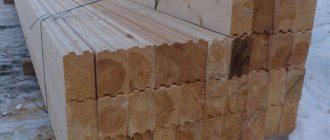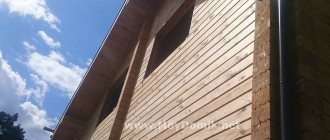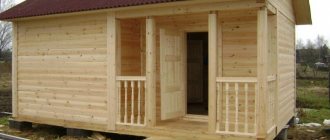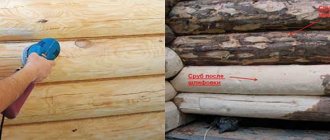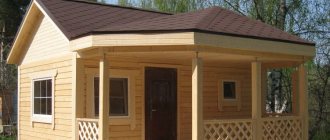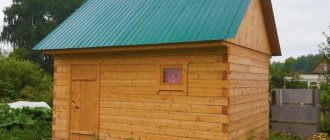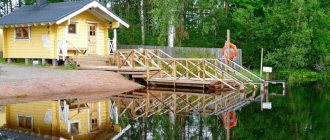Hello, my name is Tatyana. In June 2022, my husband and I began building a house on the territory of SNT within the city of Chelyabinsk.
When choosing materials for the house, we chose between full timber, gas block and double mini timber.
The beam shrinks greatly. Heating an aerated block requires large resources; in SNT only electricity is available - there is no gas.
Therefore, the choice fell on the “double beam” or mini-beam technology. The technology allows you to get a warm house for a relatively low price, and assemble it in a few weeks.
The house was built by two people - my husband and his brother, I helped a little. None of us had much construction experience.
Special equipment was called in to install the well, sewerage and foundation; all other work was carried out independently.
About construction technology
What is a mini-beam? Strictly speaking, this is not a timber, but a dry profiled board 137x42 mm. The wall of a house assembled using this technology is double - it consists of two boards and the space between them for insulation. The total wall thickness is 227 mm.
The house is assembled like a standard log house, only with an external and internal contour. All parts are numbered for convenience, instructions are included.
First, the first crown is assembled: parts of one plane are attached to each other in a tongue-and-groove manner, then the second plane is assembled, then assembly continues according to the diagram.
The space between the beams is filled with ecowool.
Before designing, we decided on the approximate layout and number of floors. According to the plans, it was supposed to be a one-story house with a residential attic, with a total area of just over 100 sq.m.
This is the layout we wanted
What is double beam
The wall of a house built using this technology is a kind of sandwich made of an inner and outer layer of dry timber, between which there is a layer of insulation, vapor and sound insulation material. The reinforced double structure provides additional strength and stability, and better retains heat inside the building.
This is an ideal option for constructing a country house, bathhouse and other buildings for year-round use. Construction costs are partially offset by a reduction in heat costs - the structure is operated in an energy-saving mode, and heat losses in such a house will be minimal. Natural (basalt) wool is used as insulation, preserving not only heat, but also a beneficial microclimate typical of houses built from wood. Ecowool will make a wooden house warmer. It is fire resistant and does not contribute to the spread of mold.
In general, a Finnish house made of non-laminated timber is 30-50% cheaper than traditional buildings made of rounded logs and laminated veneer lumber. At the same time, the owner himself chooses the architectural design and appearance of his home: there are dozens and even hundreds of modern design options for buildings made of timber.
Design. House kit cost
We found a manufacturer of house kits with a good reputation in the neighboring region. Together with the manager, we drew up a sketch, after which we signed a contract for the design of the log house.
3D model of a house
We were completely satisfied with the finished project. The price of a cube of finished timber from the company is 17,500 rubles; according to the report, it should have taken 28.98 m3 per house.
- Design RUB 16,500
- House kit 507,000 rub.
We could only wait until the specialists prepared the material - sawed it, dried it, cut grooves and tenons, and cut out cups. The manufacturer reported a readiness time of 1 month.
Areas of use
Naturally, you may have a question about what else (besides residential buildings) is allowed to be built using the technology we are considering. The answer is the following list of its possible applications:
- construction of baths and similar health complexes;
- organization of recreation areas, including a barbecue with a gazebo;
- arrangement of modern children's playgrounds and sandboxes;
- production of wooden canopies in summer cottages;
- organization of parking spaces for vehicles;
- production of special furniture samples.
We will separately consider the nuances of producing blanks for this technology.
Ready-made “double” house
Communications: well and sewerage
During the production of the wall set, we laid communications.
A drilling company was invited to construct a well. In our area, the water lies at a depth of 25 meters. After drilling the well, the pump was lowered inside. Then, using an excavator, they dug a hole around the hole in the ground to install a reinforced concrete ring. A hatch with a cover was installed on top of the resulting structure. They laid a water pipe to the house. Spent 1 day.
- The water well cost 48,000 rubles.
Specialists were also called in to install the sewer system using an excavator. The first step: we dug a trench from the point of entry into the house to the cesspool. Second step: we dug a hole 1.5×1.5×3 m to install reinforced concrete rings. Third step: installed reinforced concrete rings with a bottom on a concrete solution in the pit. Fourth step: coated all seams with bitumen mastic, installed a hatch with a cover. A HDPE sewer pipe was laid in a dug trench on a sand bed. A 20 cm layer of sand was poured over the pipe. Then everything was covered with soil remaining after digging the trench and hole (3 cubic meters).
- 23,800 rubles on sewer installation
- Communication costs RUB 71,800.
Types of insulation
Mineral wool. The material has good air exchange, which in turn is ideal for “breathable” wooden buildings. This type of wool is fire resistant, has a long service life, and is resistant to chemicals. Disadvantages include the need for waterproofing, or the use of special compounds with hydrophobic properties. The environmental friendliness of such cotton wool is also still a matter of debate.
Styrofoam. An environmentally friendly material, which also has almost no shelf life. At the same time, it is lightweight, extremely cheap and has excellent insulating properties. However, it does not allow air to pass through, which is a disadvantage. The susceptibility to rodent attacks can also be considered a minus.
Expanded polystyrene. Some call this material foam, but in reality it is not. Expanded polystyrene is stronger, has more weight, but at the same time allows water, air and sounds to pass through better due to the larger number of voids. At the same time, it retains heat several times better than polystyrene foam.
Ecowool. Produced from pulp industry waste. The composition does not contain poisonous or toxic substances. However, the ideal fire retardant in its composition is borax, but the same boric acid is less preferable due to its not very pleasant odor and the decline in fire-fighting properties over time. In addition, special equipment is required to spray this cotton wool.
Important! Various types of insulation are very susceptible to high humidity, losing their properties under its influence. In this regard, laying insulation should be done only in dry and warm weather.
Foundation and floor
Since a house made from double timber is quite light, a capital foundation is not required; a pile foundation is sufficient. We used a drilled foundation. Its construction required: a hole drill, metal reinforcement, asbestos-cement pipes and concrete.
To begin with, we calculated the number of piles (20 pieces, it could have been less), marked the future house using wooden pegs, and leveled them. Next, they called a hole drill, and in the marked places the specialist drilled holes of the required depth (2 m).
Pipes were installed in the holes, 3 rods of reinforcement each, and filled with concrete. After the mixture had hardened, the piles were brought into one plane using a laser level, and the excess was cut off using a grinder. Metal square heads were installed on the upper part of the support, secured with concrete, and covered with waterproofing.
- Foundation RUB 46,200, 2 days
For strapping, a dry board (50*200 mm) treated with an antiseptic and fire retardant was used. Processing and material – RUB 32,200.
OSB boards served as the base of the floor - RUB 100,000.
- Strapping and flooring RUB 132,200, 2 days.
Design features
When you carefully study the “double beam” technology, you will immediately notice some features of its implementation related to the design of prefabricated elements. First of all, what is striking is that it is based on a system reminiscent in its structure of standard sandwich panels. In this case, the wooden sidewalls of the frame base mirror each other, and insulation in one or several layers is placed between them (selected depending on the region of residence).
Hidden communications can be laid
The thickness of the timber sidewalls usually does not exceed 70 mm, but you can choose this value at your discretion (it should also be tied to the climatic conditions in your area).
The versatility of this material is also manifested in the fact that using the “double timber” technology it is possible to erect buildings with a wall height of up to 10 meters and a thickness of up to 340 mm.
Exceeding the specified thickness is allowed, but there is no point in this, since in a building with such indicators, comfortable living conditions are provided by the wall structure itself
Delivery and assembly
Delivery of the finished set of walls to our city using a truck cost 21,000 rubles. (200 km). The manufacturer packed the finished parts into pallets using a tie; for unloading, the services of a manipulator were required - 5,000 rubles.
- Delivery 26,000 rub.
After delivery, we read the instructions - the manufacturer provided a plan for the axles and rims.
Crown plan
We started assembling (we assembled it ourselves).
To begin with, using iron corners, we attached the boards of the first crown to the OSB floor. Next, using rubber mallets, we attached the boards of the 2nd crown to the 1st crown. When assembling, it is important to carefully punch each beam along its entire length, otherwise the house may become deformed and blow out. Next, the assembly continued along the crowns.
After assembling the 1st floor, the ceiling was installed. We used a dry treated board 200x50 mm, pitch - 0.45 m. For the subfloor - 25x150 mm.
- Flooring and flooring RUB 25,000, 1 day
Next, we made a rough staircase from scraps of boards, taking one day to complete.
Then the second floor was assembled according to the design.
Assembly of the 2nd floor
After completing the assembly, we installed a regular advertising banner instead of the roof to prevent moisture from getting inside.
In total, the assembly of the walls took 4 days.
Features of the technology
The quality of buildings largely depends on the correct selection of materials. Only high-quality timber (or mini-timber) dried using the chamber drying method is suitable for residential buildings.
This technique guarantees a minimum moisture content in the wood (no more than 14%). Dry timber does not deform or become cracked, and the houses themselves retain their ideal geometry throughout their entire service life. At the same time, poorly dried timber is wasted money. In this case, all the advantages of the technology are neutralized, and the building itself will be fragile and cold.
The absence of adhesive is another important condition. Non-glued laminated timber does not contain formaldehyde resins and other artificial additives, which means it is more environmentally friendly and safe.
A few expert tips to consider:
- carefully choose the supplier company (if you are building it yourself) and the developer - there are many unscrupulous companies on the market that are not able to provide buildings with the proper quality;
- do not skimp on hydro- and vapor barrier, as well as on the quality of insulation - the comfort in the house and its energy-saving indicators depend on this;
- the amount of insulation must be precise: excess will lead to deformation of the walls, lack of insulation will lead to heat loss;
- laying insulation and all construction work is carried out in dry weather;
- Electrical communications can be laid in the walls, but it is better not to hide plumbing and heating in the walls.
When developing a project, not only the size and layout are taken into account, but also calculations of snow and wind loads characteristic of a particular area are performed.
Electrical wiring
Since the power grid in the SNT territory is “weak”, they decided to connect to the city network. I had to install a pole on the site.
- Supplying electricity costs 16,500 rubles, the process took almost 2 months (due to red tape with the energy company).
The electricity was turned on after all, and all we had to do was install the wiring inside the walls of the house.
Wiring inside walls
Junction Box
Used:
- more than 300 m of cable and corrugated HDPE/NG;
- 100 installation sites;
- distribution boxes;
- socket boxes, small consumables.
- Posting RUB 34,000, 2 days.
Choice of insulation
The choice of material for wall insulation plays an important role in the comfortable and trouble-free operation of the finished home. The final decision on the choice of the type and thickness of insulation must be made on the basis of thermal engineering calculations for a specific building. This calculation takes into account all the main parameters of the future home: room area, number of floors, number and size of windows.
The main materials for insulating “double timber” are given below:
- Mineral wool;
- Expanded polystyrene;
- Foam chips;
- Natural insulation;
- Ecowool.
Mineral wool is one of the most common insulation materials used in construction. The disadvantages of mineral wool when insulating walls made of “double timber” are shrinkage and the need to use a vapor barrier. As mentioned above, a feature of walls made of “double timber” is the loss of condensation inside the walls in winter, and to avoid getting the mineral wool wet, vapor barrier membranes are used. With prolonged use, such insulation can shrink, which will lead to the formation of voids in the walls and a decrease in the thermal efficiency of the building. The advantages of mineral wool insulation are economical price, ease of installation and low fire hazard (to find out how to insulate walls with mineral wool, read the article here).
The density of insulation for walls must be at least 50kg/1m3.
Expanded polystyrene insulation has good thermal conductivity characteristics, does not shrink and is not susceptible to moisture. Due to the fact that this insulation practically does not absorb moisture, condensation inside the walls will accumulate between the insulation and the wooden frame of the walls, which can lead to rotting of the wood or the formation of fungus. Due to its high rigidity, this insulation is difficult to fit to all internal wall cavities; also, polystyrene foam boards are a rather expensive material for wall insulation.
Expanded polystyrene emits formaldehyde and is a flammable material that releases toxic fumes when burned.
Foam chips are a similar type of insulation to expanded polystyrene. At a lower price, polystyrene foam is characterized by strong flammability with the release of poisons during combustion, the release of formaldehyde and the destruction of the material during prolonged use. To learn how to properly insulate a house with polystyrene foam, read the article here.
Natural insulation materials include such materials as chopped hay, flax and sawdust. Dried and crushed hay or sawdust is poured into the wall cavities, does not cake and does not form cavities. Insulation is made from flax in the form of rolls and mats similar to mineral wool insulation. On sale you can find both insulation made from 100% flax, and insulation with the addition of binding components (starch or polyester). The main problem of such insulation materials is their high flammability. Antipyrite additives partially solve this problem. Also, mice and other rodents feel great in walls insulated in this way. This method of wall insulation is currently the most rarely used and should be used only if the environmental factor is in the first place when building a house.
Ecowool is the best option for insulating a house made of “double timber”. This material is made from recycled cellulose, which is crushed to a fibrous loose mass, and not only has excellent heat-saving characteristics, but also absorbs noise well. During the production of ecowool, chemical additives are introduced into the cellulose mass, thanks to which the fibers of the material do not absorb water and are slightly flammable even when exposed to direct flame. Insulation of walls made of “double timber” should be done using a special installation that blows the insulation into the space between the wooden panels. The density of wall filling with ecowool should be controlled by a specialist, since excess insulation can “spread” the external and internal contours of the wall, violating their geometry. Insufficient insulation density will lead to its shrinkage and the formation of voids in the upper part of the wall.
Insulation
Next, the walls were insulated using ecowool (finely shredded paper with the addition of boric acid and fire retardant).
Before starting work, we installed door and window frames and used the material left over from the ceiling and framing.
We calculated the insulation taking into account the required density (55-65 kg/m3). The volume of the walls is 30 m3, 30*65 = 1950 kg of wool. The mixture is sold in briquettes of 15 kg, 1950/15 = 130 briquettes.
- The price of insulation is 33 rubles/kg, 1950*33 = 64,350 rubles.
- To blow in the cotton wool, we rented a unit for 6,000 rubles and insulated the house for 3 days.
The house was insulated using a dry method, without water or glue. At the first stage, the apparatus and insulation briquettes were lifted into the attic. Next, the cotton wool was poured into the loosening tank of the installation, a long hose was lowered inside the wall to the floor level of the 1st floor, and turned on. First, the unit fluffed up the cotton wool, then, under strong pressure, fed it through a hose. All that remained was to control and direct.
Insulated floor of the 2nd floor
All walls were consistently insulated. The ecowool still remained and was used to insulate the floor of the 2nd floor.
Construction stages
Ordering elements of a double beam system is done on the basis of a developed project, where the number of parts, their length, and type of elements are indicated. Prepared workpieces are numbered , placed on pallets and sent to the construction site.
Stages of building a house using the double house kit system:
- excavation work, foundation installation;
- construction of walls simultaneously with insulation and vapor barrier;
- installation of door and window openings;
- finishing inside and outside.
Tongue-groove connection does not involve the use of screws, studs, ties, bolts, adhesives and sealants. Precisely fitted parts ensure strength, reliability and rigidity of the structure.
Assembling the walls takes an average of 2 weeks if specialists work, then the process of insulation and installation of the roof begins.
Assembly work is carried out from scaffolding or high scaffolding, so that it is convenient for workers to lay subsequent tiers.
Foundation
Trench for a strip foundation
Markings are made on the site ; before starting excavation work, a vegetation layer 10–15 cm thick is removed. Trenches are dug manually, or excavators are used if the volume of work is large.
Types of foundations for a house made of double timber:
- Tape concrete with reinforcement. The depth is taken according to the project; usually a trench is dug to 50–70 cm. The bottom is cleaned to the planning mark. The formwork is made of boards, chipboard, hardboard, and reinforced with wooden blocks 50 x 50 mm. At the bottom, longitudinal reinforcement with a diameter of 8–10 mm is placed in several rods, which are connected across by welding or knitting wire.
- Columnar type. They are made of concrete pillars or made of red brick. The pillars are connected to each other by beams made of a metal angle (No. 100 - 150), a channel (No. 100 - 120), and a wooden beam with a section of 200 x 150 mm.
- Pile foundation. Piles are purchased factory, screw type. A twisting device is prepared at home. In this way, one element is installed by 2 people. Driven piles are rarely used, as special equipment is required.
Concreting is carried out in one stage. The base hardens on the 3rd – 4th day, but gains full strength on the 28th day; it can be loaded after 14 days of exposure.
Construction and insulation of walls
Filling the space between the frames with ecowool
The first beam is fixed to a strapping beam or board placed on a concrete strip. During the installation process, the more unsightly side of the kit is turned into the space where the ecowool will be blown. Overcuts are needed to ensure the rigidity of the walls.
If the elements are long , a solid beam of the appropriate cross-section is installed inside the wall for bandaging.
They use ecowool, mineral wool, polystyrene foam, and expanded polystyrene. Experts recommend the first option. Properties of cellulose insulation (ecowool):
- environmentally friendly material additionally insulates from noise;
- consists of crushed paper or wood pulp (80%) and antiseptics, fire retardants (boric acid, borax) - 20%.
The material belongs to the fire-resistant category , it is biologically resistant. Ecowool is blown in with special installations after completing each stage of the wall (crown, first tier, second floor).
Installation of windows and doors
Walls made from a double house kit have minimal shrinkage , but the end of the wall is open, making it inconvenient to attach a window frame to it. To install the loot, a special frame is made, which consists of a wooden board. A full-fledged casing is installed using the tongue-and-groove type; for this, an internal groove is sawed along the length of the auxiliary board.
Features of casing fastening:
- a convex tongue is made on the outside of the box;
- it is inserted into the groove on the side end of the wall;
- the casing is not attached to the walls; it must move freely in the event of shrinkage and shrinkage of the house.
During installation, insulation is used, which is placed between the wall and the casing. A wind strip is installed at the top to prevent blowing. A window frame is installed in the casing; it is fixed to the casing with self-tapping screws.
Vapor barrier
Blowing from outside is eliminated with a windproof membrane . Internal vapor barrier serves to prevent condensation and moisture accumulation inside the insulation. The thickness of the insulating ecowool should not be less than 130 mm in order to reduce the influence of the cold outer shell on the inner one.
Installing insulating membranes solves the following problems:
- prevention of dampness inside the structure;
- equalizing the humidity of the outer and inner boards;
- preventing distortions and cracks.
The insulation works efficiently if it is in a stable and dry state , and the air particles inside it are not blown out.
Finishing
The timber must be treated with a protective compound.
The tree has a beautiful structure when cut. To emphasize it, decorative products are used that are water-based, oil-based, or based on natural oils .
The category of preparations for finishing buildings made of double bars includes:
- stains;
- paint and varnish impregnations;
- wax oils;
- drying oils
Some products have a double effect , for example, they protect against moisture, prevent the development of parasites and decorate the surface. The solutions are absorbed into the wood, penetrate between the fibers, and increase the attractiveness of the walls inside and outside the building.
Valera
The voice of the construction guru
Ask a Question
Wall elements are impregnated at the factory, so decorative compounds are used for finishing. But during the assembly process it is necessary to saw off the ends of the elements, so unprotected areas appear. Moisture penetrates from the end of the boards, leading to curvature and swelling, so open sections are treated with special protective impregnations. It is better to use certified preparations based on natural and organic ingredients.
Roof structure
The next stage was the installation of rafters, sheathing, corrugated sheeting and roof insulation.
For the rafters we used a 50x200 mm board, for the sheathing - 15x100 mm (treated with OBZ).
- Boards 20,000 rub.
The rafters were attached to the side walls and the ridge wall using metal corners, in increments of 0.6 m. The sheathing was screwed on top of the rafters using self-tapping screws.
Next, corrugated sheeting for the roof was attached to the rafters.
- Corrugated sheeting and fasteners RUB 40,000.
We attached waterproofing from the inside and laid Izospan insulation (roll, 200mm).
- Roof insulation RUB 25,000.
- Total cost 85,000 rubles, time – 3 days.
Advantages
The main advantage of a house built using this technology is its energy efficiency. The ability to vary the thickness of the insulation in the walls ensures that the house meets the highest standards for heat conservation. Now there is no need to explain to anyone that the higher the energy efficiency of a house, the lower the cost of heating it in the future.
The next important advantage of the “double timber” is the environmental friendliness of the technology. Wood is rightfully considered the most favorable material for the construction of residential buildings, and a competent choice of insulation and finishing materials will allow the owner not to worry about possible harmful fumes from siding or drywall.
The speed of installation is ensured by the simplicity of construction technology. Such a house is relatively light and does not require the construction of massive foundations, which also saves time on building the house. When constructing walls from fairly light materials, you do not have to use lifting equipment.
The absence of shrinkage is ensured by the use of lumber with a moisture content of 12-14%. If this rule is observed, such a house can begin to be used immediately after completion of construction and not wait until the house “sits down.”
Installation of windows and entrance door
Since the attic windows are non-standard, the order had to wait longer than usual (3 weeks); mounting plates and foam were used to secure the windows.
One side of the metal plate was attached to the casing, the other to the window, the space between was filled with polyurethane foam
- Windows 61,000 rub., 1 day.
We ordered a metal door. The installation didn't take long. The door was secured with wood groins to the casing, and the remaining space between the jamb and the frame was foamed with polyurethane foam. We assembled the door hardware.
- Door 15,000 rub., 3 hours.
How to build houses from double timber on a turnkey basis
We have already said above that the creation of such buildings is best left to professionals. Of course, this is more expensive than doing it yourself, since the company usually supplies materials, develops the project, and is engaged in construction. However, in this case, if you are lucky with the company, there is no doubt about the quality. Such a service usually includes several stages:
- Creating a project. The process can take several weeks and during the implementation of various stages it must be agreed upon with the customer. At this stage, not only the architecture of the future home is selected, but also the list of materials used, taking into account a number of factors;
- Production of building materials. The process takes place at the construction company's facilities. As a rule, it does not take much time, since the creation of these components occurs quickly, and besides, standard components are almost always available in stock;
- Delivery of materials to the site and assembly of the house. Creating houses using this technology resembles a kind of assembly of a designer. All components, as well as insulation materials, are delivered to the site, the foundation is erected, which in most cases is not massive, and the house itself is built. Usually, when ordering, a house is built to the point of being fully ready to receive residents.
Finishing
- The ceiling on the first floor was covered with clapboard 13,000 rubles, 1 day.
Double timber does not require finishing as such; it is necessary to lightly sand the surface and cover it with oil or paint. We chose a 2 in 1 impregnation – antiseptic and transparent strengthening paint.
- Impregnation 15,000 rubles, 2 days.
- The floor of the 1st floor was covered with linoleum, 20,000 rubles, 1 day.
What buildings are being built using this technology?
Finnish construction technology has universal application - both miniature bathhouses in summer cottages and two-story cottages are built from timber.
The list of buildings includes:
- residential country houses;
- dachas;
- guest houses in suburban areas;
- baths and saunas;
- outbuildings (workshops);
- wooden garages;
- gazebos, terraces, patios, decorative structures.
The most reliable way to build such a structure is to order services from a professional company. Experienced specialists will develop an original architectural and design project adapted to your area, select materials and construct the structure as quickly as possible.
The double beam technology in house construction involves completing a turnkey task - erection of load-bearing elements of the building, insulation, installation of floors and internal partitions, communications, installation of windows and even interior decoration (if provided for in the contract).
Heating and plumbing
For heating, we purchased a 9 kW electric boiler (3 heating elements of 3 kW each, can be used separately), a pump, metal-plastic pipes, bimetallic radiators, fastenings, and fittings.
We stretched the pipes along the 1st floor, attached radiators to the walls, and connected them to the boiler.
We installed a pressure maintenance station and a water heater, laid pipes for cold and hot water.
- Heating 50,000 rub., 1 day.
- Water supply RUB 25,000, 1 day.
